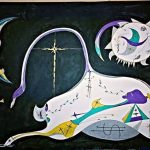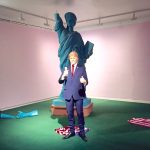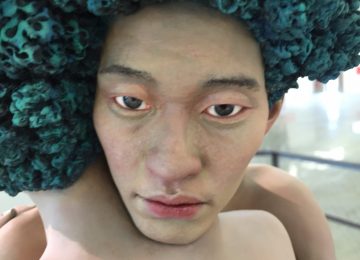Meeting South-Korean art at Vestfossen Kunstlaboratorium in Norway
For norsk trykk her.PLEASE RETURN TO BUSAN PORT
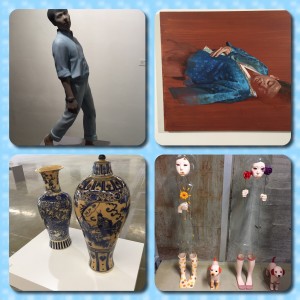 In the main exhibition of the year at Vestfossen Kunstlaboratorium (VKL); PLEASE RETURN TO BUSAN PORT, we are going to meet 21 artists from South Korea. Therefore it may be interesting to ask if we can find a common identity which is expressed in their works, and how do we approach this art?
In the main exhibition of the year at Vestfossen Kunstlaboratorium (VKL); PLEASE RETURN TO BUSAN PORT, we are going to meet 21 artists from South Korea. Therefore it may be interesting to ask if we can find a common identity which is expressed in their works, and how do we approach this art?
Choi & Lager
The successful duo Sunhee Choi and Jari Lager are curators of the exhibition, and they have been working together for many years. Therefore it is particularly interesting to approach this exhibition. The title of the exhibition is from a song well known by the South Koreans, and it is also the title of one of the works in the exhibition. In spite of the differences in each artist expression, they all have, according to the curators, a common desire to turn their eyes back home after a long time in the international art world.
South Korea
In 1948 Korea was divided into North and South Korea, but before that they had been occupied by Japan for a long time. South Korea was supported by the US and the search for communists and spies from North Korea who where supported by Soviet Union led to many riots. After the well known Korean War (1950 - 1953) there was a frequent shifting of leadership. In 1960s the students revolted against the undemocratic leadership, known as The April Revolution.
There were more riots to come, but from 1987 South Korea became a fully democratic country with what is called the sixth Republic. South Korea's urbanization and economic growth hit eventually speed, and today South Korea is a rich country, a G20-country. Back in the 1980s it was also focused on culture and many museums were built, also one for contemporary art. As many will remember; South Korea was also host to the Olympic Games, when it was held in Seoul in 1988.
So what about the artists represented at VKL? Although they haven't grown up during all the troubles , they have grown up in the aftermath of them, and most of all they have experienced the great economic growth; sometimes referred to as the identity of South Korea. All though they have been working and living in different parts of the world, and therefore their cultural filter will be different, as well as what they identified themselves with, so let us take a look at some of the art works represented in this exhibition.
Choi Xooangs
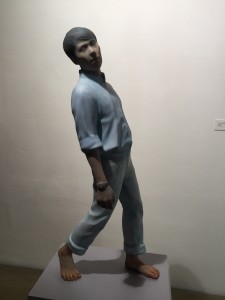 The first to catch your attention may be Choi Xooangs' sculpture Walk. It's a person in a relaxed walking position. Weight rests on his right foot. His head, shirt, pants with belt, and watch is partly obscured, covered with a kind of film. We can interpret it as a symbol of Maya. The feet, on the other hand, is hyperrealistic in a way that can remind us of Tony Matelli. These hyperrealistic feet stand in a stark contrast to the other part of the body. As an observer; how do we understand this work?
The first to catch your attention may be Choi Xooangs' sculpture Walk. It's a person in a relaxed walking position. Weight rests on his right foot. His head, shirt, pants with belt, and watch is partly obscured, covered with a kind of film. We can interpret it as a symbol of Maya. The feet, on the other hand, is hyperrealistic in a way that can remind us of Tony Matelli. These hyperrealistic feet stand in a stark contrast to the other part of the body. As an observer; how do we understand this work?
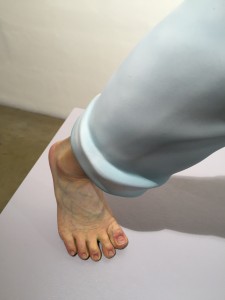 Maya originates from Hinduism and can be translated into illusion; you can't see all of the reality. What is it we cannot see in this sculpture; is it the observer that cannot see or is it the sculpture itself that has something hidden? And what about the feet that seem like they have been frozen? Is the sculpture a representation of the alienated man that is unable to fit into the globalized world, or all the changes that has taken place in the artist's homeland?
Maya originates from Hinduism and can be translated into illusion; you can't see all of the reality. What is it we cannot see in this sculpture; is it the observer that cannot see or is it the sculpture itself that has something hidden? And what about the feet that seem like they have been frozen? Is the sculpture a representation of the alienated man that is unable to fit into the globalized world, or all the changes that has taken place in the artist's homeland?
There's more of Choi Xooangs' sculptures in the exhibition, and they all communicate with us in a sublime way; the hyperrealism makes them fascinating and at the same time they have a kind of abstraction.
Yu Jinyoung
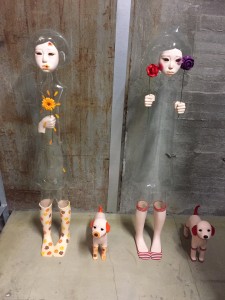 Yu Jinyoung is another artist represented with several sculptures where the body has been made by PVC, something that makes them transparent, and they all have a sad expression. As a contrast we also find childish pattern on their socks etc. and they all have an opak pet as an attribute. The artist is concerned with the "invisible" people , the people that not are being noticed. How is it being a human being like this, and is it recognizable?
Yu Jinyoung is another artist represented with several sculptures where the body has been made by PVC, something that makes them transparent, and they all have a sad expression. As a contrast we also find childish pattern on their socks etc. and they all have an opak pet as an attribute. The artist is concerned with the "invisible" people , the people that not are being noticed. How is it being a human being like this, and is it recognizable?
Parada-Kim Helena
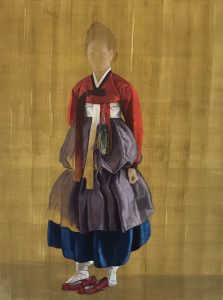 Parada-Kim Helena is another artist we meet in this exhibition. She stands out a little from the others in terms of background and upbringing; she's half Korean and half Spanish and grew up in Germany. Nevertheless, here she is representing in a context that deals with Korean art. Her paintings have a form of portait, where people bearing famous Korean costumes, while their faces are made partly or completely in abstraction.
Parada-Kim Helena is another artist we meet in this exhibition. She stands out a little from the others in terms of background and upbringing; she's half Korean and half Spanish and grew up in Germany. Nevertheless, here she is representing in a context that deals with Korean art. Her paintings have a form of portait, where people bearing famous Korean costumes, while their faces are made partly or completely in abstraction.
Shin Meekyoung
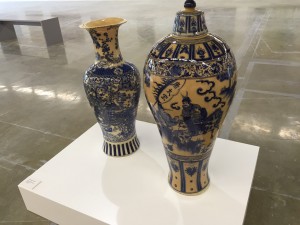 Shin Meekyoung is from South Korea but lives and works in London most of the time. She is represented with beautiful sculptures made of soap, and when you approach them, you can smell soap fragrance. You will meet Chinese jars, as well as Buddha; all made of soap. In Buddhism they belive that everything are of transient value, even the human being, therefore soap is a perfect material to make a Buddha statue.
Shin Meekyoung is from South Korea but lives and works in London most of the time. She is represented with beautiful sculptures made of soap, and when you approach them, you can smell soap fragrance. You will meet Chinese jars, as well as Buddha; all made of soap. In Buddhism they belive that everything are of transient value, even the human being, therefore soap is a perfect material to make a Buddha statue.
Ji Yeo
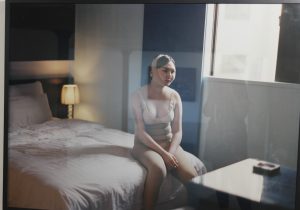
Ji Yeo is an artist who in many ways are documenting an international phenomenon; plastic surgery. We are meeting pictures of operation rooms and of people in their convalescence period; a painful time in many ways, all in search of the perfect look. Is it the ancient ideals they are seeking, where the proportions were given in a mathematical formula?
Kwon Jukhee
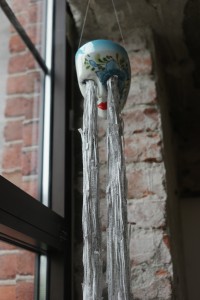
Kwon Jukhee is using the book as a symbol for knowledge and science in his installations. But the book is shredded and the paper strips are flowing over from different objects; one from the eyes of a beautiful porcelain mask and it hits a broken mirror. A mask is hiding something, and what about the symbolism of the broken mirror? What kind of knowledge and science have been lost; we can only wonder. We are getting a sublime feeling, given by the contrast of the beautiful mask and the broken mirror, not to mention the lost knowledge, symbolized by the paper strips.
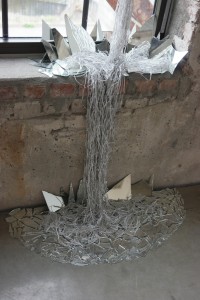
Lee Byungchan
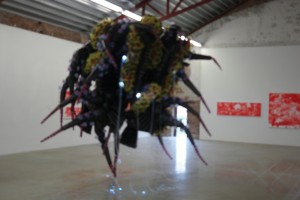
As we enter the top floor, we start wondering if it's Louis Bourgois' spider which are facing us, and for a moment we are mentally prepared to wander further into her claustrophobic rooms. It is, however, Lee Buyngchan's installation it's about. The artist are using plastic bags and other objects to create his kinetic work; it is filled with air so that it inflates, then contract because the air is being sucked out, over and over again. At first sight it is dark, but when it inflates colourful plastic displays. Using different kind of "garbage" in art like Byungchan has been done many times before; Robert Rauschenberg and Jasper Johns were among those who paved the way, but it works very well here as well.
Other artists
We encounter many more artists in the exhibition; like Kwon Soonhak with his interesting documentary wall with references to the Korean War, from the perspective of the British soldier David Kamsler MBE, who participated in the war.
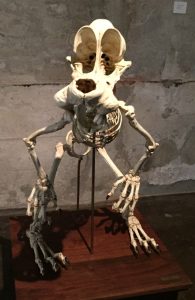 Lee Hyungkoo with his cartoon characters, or maybe it isn't just that? Na Hyun who is keen to highlight social and ecological themes,
Lee Hyungkoo with his cartoon characters, or maybe it isn't just that? Na Hyun who is keen to highlight social and ecological themes,
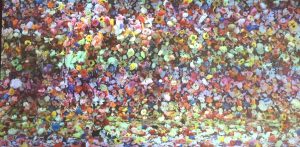 Lee Yongbaek with his video Angel Soldier which seems to start with flowers, but the flowers are camouflage for soldiers. Stella Sujin has references to Michel Foucault's ideas while Kim Ayooung is concerned about how history is not remembered the way it really was. She is also the artist behind the main work in the exhibition named "Please return to Busan Port", and still there are more artists to meet in this exhibition.
Lee Yongbaek with his video Angel Soldier which seems to start with flowers, but the flowers are camouflage for soldiers. Stella Sujin has references to Michel Foucault's ideas while Kim Ayooung is concerned about how history is not remembered the way it really was. She is also the artist behind the main work in the exhibition named "Please return to Busan Port", and still there are more artists to meet in this exhibition.
Then back to the question; how do we approach this art in the main exhibition of this year at VKL, and can we, without going in a pitfall of stereotypes, find some common identity expressed in the works?
Looking at the previously mentioned works, it is easy to find a common denominator; there are works which in one way or another challenge their viewers, like all good art does:
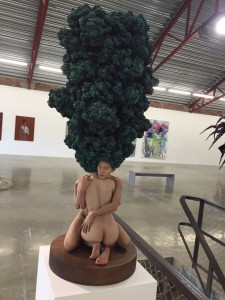 Choi Xooangs with his sculptures as we were struggling to get on; they catch us in its hyperrealism, but what is it the artist communicates with us through his sculptures? The fast growing economic developments are seen by many as part of the South Korean's identity, but perhaps it is not easy for everyone to enjoy much of this development, is this what the artist is trying to communicate with us?
Choi Xooangs with his sculptures as we were struggling to get on; they catch us in its hyperrealism, but what is it the artist communicates with us through his sculptures? The fast growing economic developments are seen by many as part of the South Korean's identity, but perhaps it is not easy for everyone to enjoy much of this development, is this what the artist is trying to communicate with us?
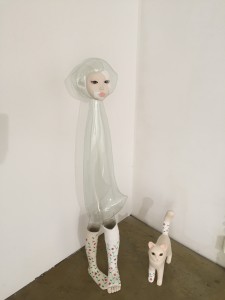 What about Yu Jinyoung's "invisible" sculptures with their sad expression that makes us wonder what this invisibility symbolizes, and what about Shin Meekyoung's sculptures made of soap, but are not to be used to cleaning purposes?
What about Yu Jinyoung's "invisible" sculptures with their sad expression that makes us wonder what this invisibility symbolizes, and what about Shin Meekyoung's sculptures made of soap, but are not to be used to cleaning purposes?
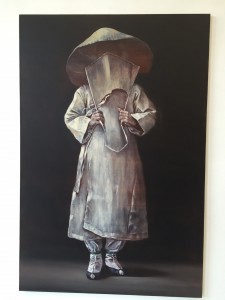 Parada-Kim Helena makes paintings with people wearing Korean costumes with abstract faces making the costumes the only identity marker.
Parada-Kim Helena makes paintings with people wearing Korean costumes with abstract faces making the costumes the only identity marker.
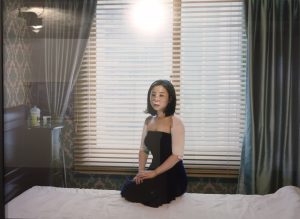 Ji Yeo is documenting plastic surgery in her art, what happens to identity then, is it another kind of abstraction?
Ji Yeo is documenting plastic surgery in her art, what happens to identity then, is it another kind of abstraction?
What about Kwon Jukhee who does installation of shredded books; where is the content of the books and what is lost? The crushed mirror used in one installation strenghtens the expression.
Finally we met Lee Byungchan's installation that made us feel that we were landed in Louis Bourgois' claustrophobic universe, but here too there is a hidden agenda, that we must spend time to understand. (See also video at the bottom of the post)
This is an exhibition that can be interpreted on many levels; with the South Korean backdrop and the turbulent and rapid development South Korea has been through after the division, Korean War and the rapid economic growth makes it perhaps even more important to search for their identity, and perhaps it is not always easy to find. We see that most of the artists have a common denominator, which we may call Maya; it is something undefined; something one cannot quit get a hold on, but if this is conscious or unconscious expression of the artists about the search of identity is not given. Yu Jinyoung has stated to the media that she often feels and want to be the invisible person in sosial contexts as her sculptures express , a wish everyone can identify with from time to time, but perhaps it's also difficult to define ones identity in relation to the homeland of these artists, a country which is constantly changing. The Norwegian artist Edward Munch painted Skrik (Scream) as an expressionistic alien feeling that enveloped in Norway when this country experienced major changes with urbanization and industrialization towards the end of the 1800s, while Sigbjørn Obstfelder expressed it in his poem "Jeg ser" (I see). Are these expressions of the artists we meet in this exhibition another expression of alienation, and in that case are the alien feeling a part of the common human identity? We saw that the curators stated that what the artists had in common was a quest to return, but what if the place you want to return to, no longer is the same as the one you left?
The art must anyway go beyond the framework and context which it is placed in, to be interesting, which also this art do. It works excellent as an international expression in a globalized world; the plastic operation will work fine as an expression for the hunt for the perfect look we find everywhere in the world today, while the sculpture Walk works equally well as a picture of the urban seemingly successful global man; an expression for a wonder at how he really feels behind his successful appearance. In a globalized world, knowledge will always get lost, what this knowledge consists of can be many things, it is just not valued high enough to keep up with the developments right then and there. Lee Byungchan's installation can be read with clear references to the environmental battle; who decides what is garbage and how can we lessen the amount of garbage in the world today, while Shin Meekyoung's sculptures of soap can get us thinking of Kant and ”das ding für mich und das ding an sich”(the thing the way I see it and the thing in itself).
So how should one approach the Korean art? It requires, as previously mentioned, much of its observer, so one should be prepared to spend good amount of time; look at the details, marvel, reflect, communicate with the works. In addition one should leave the idea that the contemporary art is difficult at home, for here it is much to gain, and maybe you get the desire to learn even more about the South Korean history and culture. Therefore it must be fair to say that both artists and curators have done their job well.
Lee Buyngchan: Urban Creature




